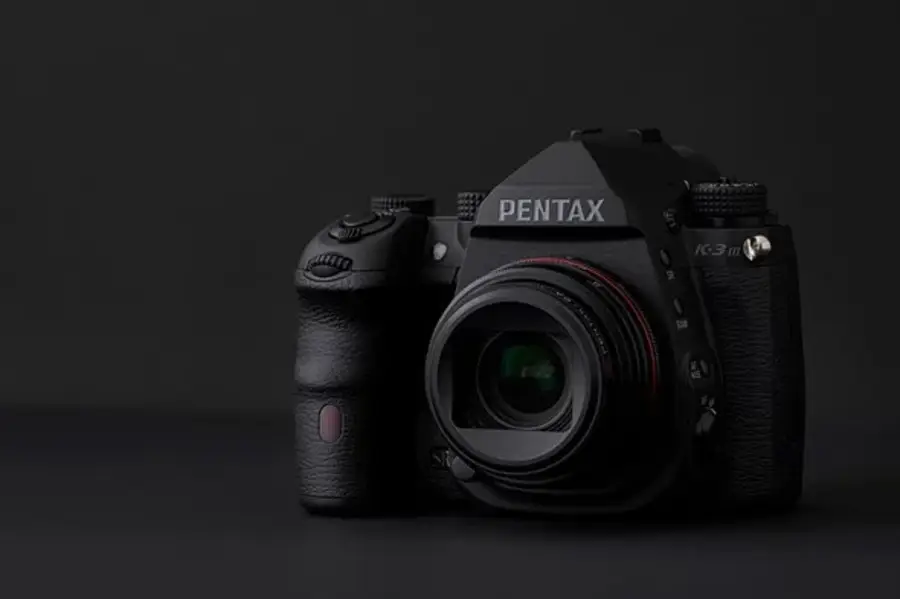Ricoh has announced a new Pentax K-3 Mark III digital SLR camera designed exclusively for black and white photography. Pentax K-3 Mark III Monochrome is a variant of its 25.7MP APS-C DSLR with no color filter array.
The K-3 Mark III Monochrome is, unsurprisingly, based on the existing K-3 Mark III (Amazon.com, B&H, Adorama ), Pentax’s flagship APS-C format DSLR. While the camera body is substantially unchanged, Pentax has made a few adjustments to reflect the camera’s monochromatic capabilities. The K-3 III monochrome gains all the usual benefits of removing the color filter: sharper images by avoiding the need for demosaicing and one stop better tonal quality than the color version, at any given ISO, because no light is being lost to filters. The low-light benefit is further enhanced by an absence of chroma noise, which means all noise presents as luminance noise, which can be read as ‘grain’ or additional detail.
The K-3 III is built around the same APS-C sized 25.7MP BSI CMOS sensor as its color-aware sibling, with the removal of the CFA boosting its base ISO by one stop. Interestingly the maximum ISO setting has not been increased.
Priced at $2,199.95, this camera is set to start shipping in late April, with pre-orders soon to be available at leading retailers such as B&H, Adorama and Amazon.
Ricoh announces PENTAX K-3 Mark III Monochrome digital SLR camera
Main features of the PENTAX K-3 Mark III Monochrome
- Monochrome-specific CMOS image sensor
To optimize the quality of monochromatic images, the camera incorporates a monochrome-specific, APS-C-format CMOS image sensor free of an AA (anti-aliasing) filter with approximately 25.73 effective megapixels. Typical color image sensors are designed to receive light passing through red (R), green (G) and blue (B) color filters, so each pixel detects only one color-data component. To compose a monochrome image, color sensors must convert color data into monochromatic data by interpolating the color data they collect. The new monochrome-specific image sensor, however, can faithfully reflect the brightness data obtained by each pixel in the image — without the interpolation process — to produce extra-fine monochromatic expression, in images high in resolution and rich in gradation.
- Image quality exclusively designed for monochrome photography
The image quality produced by the original PENTAX K-3 Mark III was thoroughly re-evaluated and totally redesigned to optimize the imaging characteristics of the new monochrome-specific image sensor. The result is highly sensitive expression with a natural bokeh (defocus) effect, rich gradation and extra-fine sharpness — an image only the monochrome-specific image sensor can deliver.
- A selection of monochrome-specific finishing touches
The PENTAX K-3 Mark III Monochrome provides three Custom Image modes exclusively designed for monochrome photography to provide distinctive finishing touches. In addition to Standard mode, it also provides Hard mode to produce high-contrast images, and Soft mode to create high-key, low-contrast images. Each mode provides minute adjustment of parameters such as tone, key, contrast and sharpness. This allows the photographer to personalize their images with the desired finishing touch.
- Exterior design reflecting the monochrome photography concept
The PENTAX K-3 Mark III Monochrome provides white backlight illumination on the LCD data panel positioned on its upper panel, while featuring “Monochrome” lettering printed on the upper-left shoulder of the back panel. Its menu screen features a black-and-white visual scheme as default, while the SR (Shake Reduction) badge is finished in silver. The icons printed on buttons and switches across the camera’s exterior are finished in three shades of gray to assist the users with their camera operation. All in all, the concept of monochrome photography is evident throughout the camera body.
Note: Since the PENTAX K-3 Mark III Monochrome is solely designed for black-and-white photography, some of its features and functions may differ from those of the PENTAX K-3 Mark III. Refer to the specification table attached to this release for other original features and functions.

